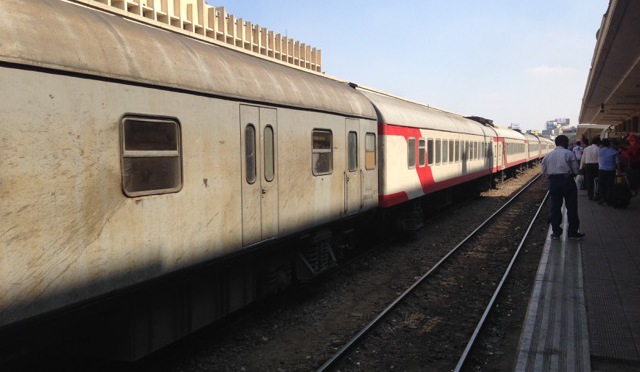From Cairo, we planned to travel south to Luxor. Unlike other regions of Africa in which we had traveled, an overstuffed minibus was not the only way to reach our destination – we had options: road, air, river, rail.1 After months and months of grueling overland travel, we quickly (and happily) rejected taking any sort of bus. Flying and cruising were both expensive options and therefore also out, leaving us with the train – which conveniently happens to be our preferred method of travel for medium-length distances.
We were looking forward to riding the train. The 671 kilometers (419 miles) route between Cairo and Luxor loosely runs along the Nile and would afford us the benefits of overland travel (watching the scenery change gradually from place to place) with a much greater level of comfort than a hot, cramped bus/minibus.
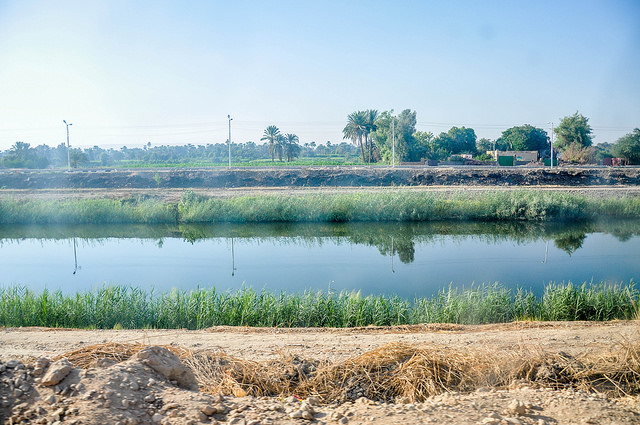
We consulted our guidebook, online forums, and seat61’s extremely helpful Beginner’s Guide to Train Travel in Egypt, and determined that our ideal trip would be on train 980, the air-conditioned express train scheduled to leave Cairo at 8:00 a.m. and arrive in Luxor just around sunset. Not only are daytime trips considerably (read: 7x) less expensive than overnight journeys on sleeper trains,2 but traveling in the daylight allowed us to enjoy the scenery and see more of Egypt.
But here’s the catch: Non-Egyptians are not permitted to purchase passage on daytime trains. Our research turned up several loopholes in this policy, the most promising being that we could simply purchase the tickets online directly from the Egyptian National Railway. Alas, although other trains were listed on the website’s schedule for our intended day of travel, train 980 was missing.
Having some free time during one of our days in Cairo, we decided to make our way to Ramses Station to test our ticket-purchasing luck with an in-person attempt.
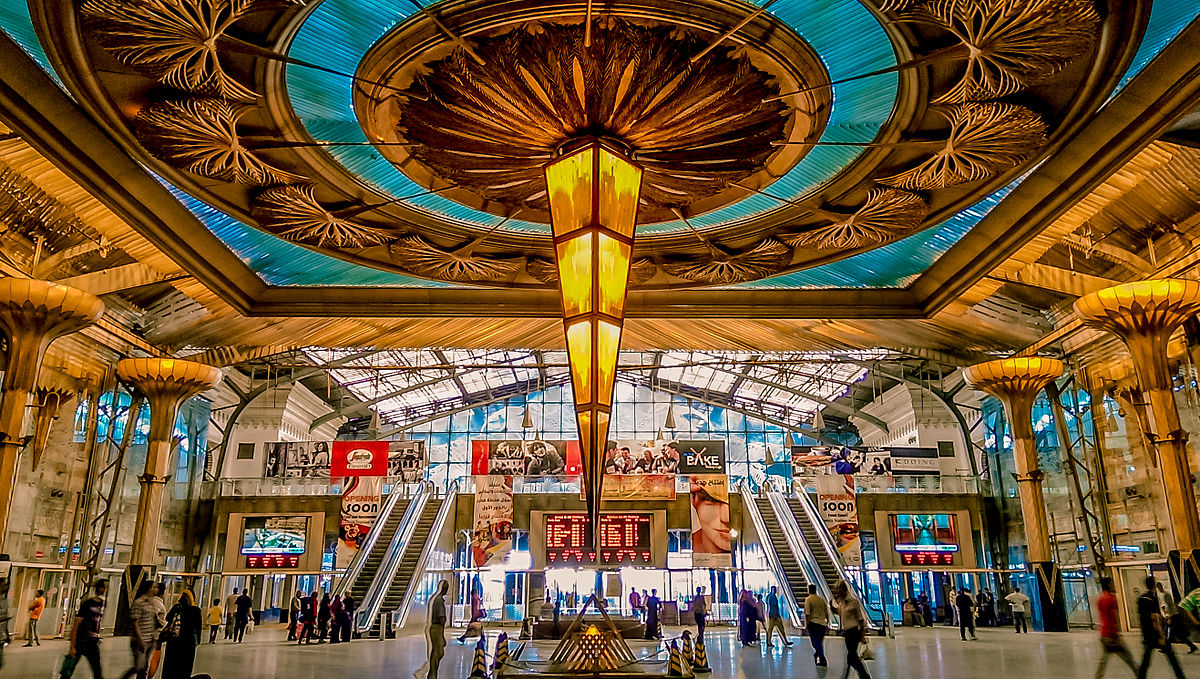
Long story short, it was a total debacle. Like many train stations the world over, Ramses Station is crowded with people in a hurry and can be difficult to navigate if you’re even the slightest bit lost. We made our way to windows where it appeared that train tickets were being vended, and then spent several minutes trying to decode the handwritten Arabic numerals on a posterboard schedule. We saw no listing for train 980, and joined a random queue to seek to inquire about its status.3
Here I’m using “queue” in only the loosest sense of the word. In front of each window, there was a jostling cluster of people, from which individuals would step up to the clerk behind the window in no discernible order and demand to be served. We observed for a few moments before hedging our bets and joining separate lines. I did my best to defend my position, but the Egyptians largely ignored me. Marc managed to reach the front of his queue and received a vague directive that tickets for long-distance destinations like Luxor were sold at some office on the other side of the station.
We followed the directions to this office as best we could, but they led us onto the platform and we were stopped by a guard demanding to see our tickets. As we tried to explain ourselves to the guard, a young guy passing through on the way to catch a train stopped to help us. He took us onto the platform and pointed out the office on the other side of the tracks that we needed to visit. He then jokingly encouraged us to make use of the underground pedestrian passageway to reach said office, rather than scrambling over the platform edges and across the tracks, as other people were choosing to do, despite the active train traffic running through the area.
At the long-distance ticket office, the threat level on our frustration raised from orange to red. After we had pushed and shoved and shouted our way to one of the ticket windows, we were told that by one of the clerks there were not any daytime trains headed to Luxor, much less our desired train 980. Not tomorrow, not the day after, not three weeks from now. There were simply no daytime trains, and, if we wanted to go to Luxor, we would have to purchase tickets on the sleeper train.4
This was obviously a blatant lie as the Egyptian National Railways website had tickets for sale for other daytime trains to Luxor, just not train 980. We expressed incredulity and skepticism, but the clerk remained firm, and, with the queue literally leaning over our shoulders, there was nothing we could do but grumble and head a few windows down to the sleeper train queue. We waited there for a few minutes and snapped at a few people who tried to cut in front of us before we decided the exercise was just a waste of time and detrimental to our blood pressure, and so we left.
From our room at the hotel that night, we recalcitrantly took the easy option that had been available to us the entire time: purchasing tickets online for air-conditioned express train 982.5 The entire operation took about five minutes – including the time it took for the hotel to print copies of the PDF tickets for us.
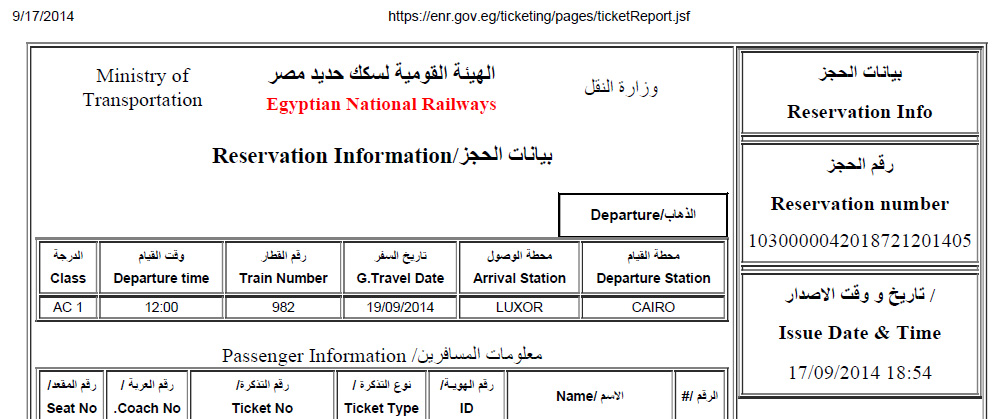
I harbored some anxiety that we would be prevented from boarding the train (or, worse, kicked off en route), but we encountered no further problems.
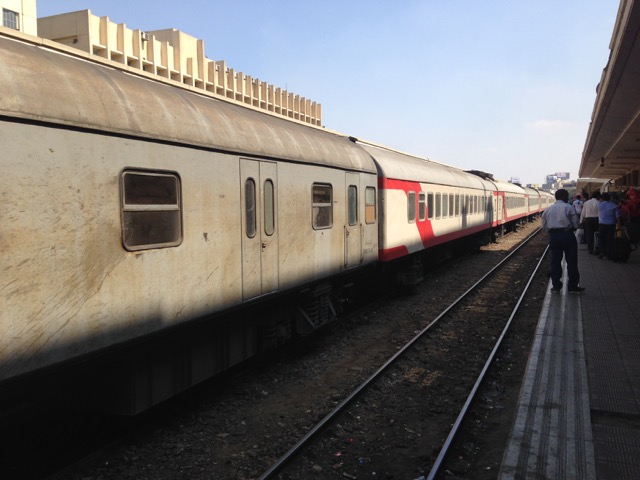
The journey was uneventful. We easily found our assigned, comfortable first class seats, stashed our backpacks in the rack above our them, and settled in for the 10+ hour ride. We had a bagful of ta’amiya sandwiches from Felfela, which we supplemented with a package of imitation Oreos purchased in the station.

As hoped, the scenery was enjoyable – we saw pyramids, the Nile, lush farmlands, parched desert, and life in the Egyptian countryside.6 It was a much, much nicer way to travel than the busses and minibuses to which had become accustomed – but, as a result, I have less amusing anecdotes. I don’t know about you, but I think that’s a fair trade.
We arrived in Luxor fairly late, and, after some frustrating negotiations with taxi drivers,7 we checked into our hotel and jumped in the pool, a luxury we had been dreaming about all day.
Where We Stayed:
☆ Sonesta St. George. Three stars. The Sonesta St. George is a huge hotel, with many rooms and multiple restaurants. During our low-season stay, however, it was like an eerie ghost town. We had some problems with the air-conditioning in our room (and some problems in getting it resolved), but they eventually moved us to a room with a balcony directly over the Nile (not to mention functional air-conditioning) to make up for it. We loved sitting on the balcony and looking out over the Nile, and swimming in the hotel’s pool. The hotel is a walkable distance to town (although not close enough to just quickly pop over) and near plenty of restaurants.
1 I tried to find a word meaning “air travel” that started with an “r” for alliteration purposes and came up blank.
2 The overnight train between Cairo and Luxor frustratingly charges widely divergent rates for Egyptians and foreigners. The foreigner rate is USD$100 per person for a double cabin. In comparison, first class tickets on the daytime air-conditioned express trains – where all passengers, irrespective of nationality, pay the same price – cost only 93.6 Egyptian Pounds (approximately USD$13).
3 While writing this, in retrospect, it seems that we clearly should have taken the hint by this point that, perhaps, train 980 was not going to work out for us.
4 One might reasonably assume that this was simply a language barrier-fueled miscommunication – we humbly concede that we only speak about five words of Arabic – but the person behind counter was rather staunch in his repeated statements to us, in English, that daytime trains to Luxor were simply not running, not that we simply were unable to purchase tickets for such trains.
5 The only reason we had not just done this in the first place – beyond being gluttons for punishment – was that train 982 was not scheduled to leave Cairo until noon, and thus would not be arriving into Luxor until nearly 11:00 p.m. Not ideal, but also not really a problem.
6 Approximately 95% of Egypt’s population lives in just 5% of the country’s territory: the area comprised of the Nile Valley and Nile Delta. The train from Cairo to Luxor thus provides an interesting window into the environments in which a disproportionate number of Egyptians live.
7 Cairo’s metered taxis had made us soft, but they had also informed us that a short (<3 kilometer) taxi ride should not cost more than 10 Egyptian Pounds. Unfortunately, the drivers of Luxor’s unmetered-taxis demanded an obnoxious amount of bargaining (i.e., guffawing at their absurd suggested prices and then theatrically walking away) to be convinced of such.

